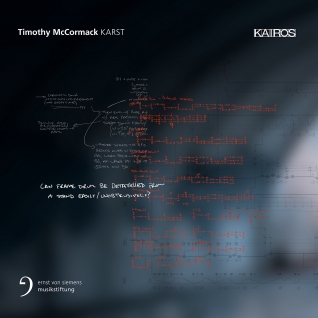Pull up an image of a karst and you’re likely to see a distressed, often vertiginous landscape of water-carved rock faces pitted with crevices and caves. Under the surface may be running water, but of course you can’t see that; above, everything appears to be dry and hard-edged. As a metaphor for music, a karst might suggest a variably textured, opaque sonic mass punctuated by silences or thinly-voiced sounds, underneath all of which is the continuity of the human touch. In fact these are the qualities characteristic of work by composer Timonthy McCormack (b. 1984) on his monograph release aptly titled Karst.
The title work, dating from 2015-2016, is a substantial piece both in length—approximately thirty-seven minutes—and instrumental makeup. The ensemble is a twenty-two piece, conductorless group that the composer has organized into four subgroups: a string quartet; a brass quintet; a quartet of flute, bass clarinet, percussion and harp; and a nine-piece chamber unit of winds, strings, piano and percussion. Karst begins almost delicately with long wind tones and silences, but it isn’t long before harsher sounds from strings and percussion erupt in brief stabs, opening the way for the work’s overall texture to thicken gradually into dense masses of pitched and unpitched sounds. And just as quickly as the strings first make their appearance, the texture thins out to empty spaces and sound clusters from smaller instrumental groupings. McCormack’s concern with gesturalism comes into play throughout the piece, and is particularly apparent in the string quartet’s use of extended techniques involving bow weight—a dramatic way of making audible the movement of arm and hand. Karst is a demanding, sometimes forbidding piece to listen to, but there is underneath a flow of more transquil sounds that periodically make themselves heard.
The smaller-scale karst survey (2016) for a seven piece chamber ensemble of piccolo, bass clarinet, soprano saxophone, piano, percussion, violin and cello as well as electronics, is in some respects Karst in miniature. Because the available resources are fewer there’s necessarily a judicious use of voice aggregation, long duration tones and extended techniques, and dynamics to create effects of mass and solid textures.
The string duo you actually are evaporating for violin, played here by Christopher Otto, and cello, played by Kevin McFarland, is an early work begun in 2011 while the composer was still a student and revised through 2014. Here McCormack’s interest in gestural composition comes to the foreground in the most unmistakable and reductive terms. The piece’s constituent elements are drawn from a virtual catalogue of advanced string techniques, the sheer physicality of which can be heard in the predominant displacement of pitch in favor of noisy sounds induced by extremes of bow weight. After an often wrenching, twenty-minute-long development of these gestural motifs, McCormack chooses to relieve the considerable sonic tension with a very quiet denouement of about three minutes’ length.







